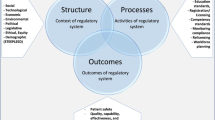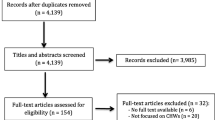Abstract
Community health workers (CHWs) are expected to improve patient care and population health while reducing health care costs. Law is a tool states are using to build a supportive infrastructure for the CHW workforce. This study assessed the extent existing state law pertaining to the CHW workforce aligned with best available evidence. We used the previously developed Quality and Impact of Component (QuIC) Evidence Assessment method to identify and prioritize those components that could comprise an evidence-informed CHW policy at the state level. We next assessed the extent codified statutes and regulations in effect as of December 31, 2014 for the 50 states and D.C. included the components identified in the evidence assessment. Fourteen components of an evidence-informed CHW policy were identified; eight had best, three had promising, and three had emerging evidence bases. Codified law in 18 states (35.3 % of 51) pertained to the CHW workforce. Fifteen of these 18 states authorized at least one of the 14 components from the evidence assessment (maximum: nine components, median: 2.5). The most frequently authorized component was a defined scope of practice for CHWs (authorized by eight states) followed by a standard core competency curriculum and inclusion of CHWs in multidisciplinary health care teams (each authorized by six states). States could consider the components presented in this article when developing new or strengthening existing law.


Similar content being viewed by others
References
Ward, B. W., Schiller, J. S., & Goodman, R. A. (2014). Multiple chronic conditions among US adults. A 2012 update. Preventing Chronic Disease, 11, E62.
Institute of Medicine. (2003). Unequal treatment. Washington, D.C.: The National Academies Press.
American Public Health Association. (2009). Support for community health workers to increase health access and to reduce health inequities. Retrieved from http://www.apha.org.
Centers for Disease Control and Prevention. (2014). States implementing community health worker strategies. Atlanta, GA: Centers for Disease Control and Prevention.
Centers for Disease Control and Prevention. (2015). Addressing chronic disease through community health workers. Atlanta, GA: Centers for Disease Control and Prevention.
The Institute for Healthcare. (2015). Triple aim. Retrieved from http://www.ihi.org.
United States Department of Health and Human Services. (2007). Community health worker national workforce study. Washington, D.C.: United States Department of Health and Human Services.
Institute of Medicine. (2010). A population-based policy and systems change approach to prevent and control hypertension. Washington, D.C.: The National Academies Press.
United States Department of Health and Human Services. (2013). Medicaid and children’s health insurance programs. Final rule. Federal Register, 78(135), 42160.
Viehbeck, S. M., Petticrew, M., & Cummins, S. (2015). Old myths, new myths. American Journal of Public Health, 5(4), 665–669.
Institute of Medicine. (2005). Preventing childhood obesity. Washington, D.C.: National Academies Press.
Brennan, L., Brownson, R. C., & Orleans, C. T. (2014). Childhood obesity policy research and practice. American Journal of Preventive Medicine, 46(1), 1–16.
Centers for Disease Control and Prevention. (2014). Understanding evidence. Retrieved from http://vetoviolence.cdc.gov/apps/evidence.
Spencer, L. M., Schooley, M. W., Anderson, L. A., et al. (2013). Seeking best practices. Preventing Chronic Disease, 10, E207.
Oxman, A., Lavis, J. N., Lewein, S., & Fretheim, A. (2009). SUPPORT Tools for evidence-informed health policymaking. Health Research Policy and Systems, 7(S1), 1–7.
Barbero, C., Gilchrist, S., Schooley, M. W., Chriqui, J. F., Luke, D. A., & Eyler, A. A. (2015). Appraising the evidence for public health policy components using the Quality and Impact of Component (QuIC) Evidence Assessment. Global Heart, 10(1), 3–11.
Centers for Disease Control and Prevention. (2013). State law fact sheet. A summary of state community health worker laws. Atlanta, GA: Centers for Disease Control and Prevention.
Massachusetts Department of Public Health. (2009). Community health workers in Massachusetts. Boston, MA: Massachusetts Department of Public Health.
Initiative, The New York State Community Health Worker. (2011). Paving a path to advance the community health worker workforce in New York state. New York, NY: The Community Health Worker Network of NYC.
Centers for Disease Control and Prevention. (2014). Policy evidence assessment report. Community health worker policy components. Retrieved from http://www.cdc.gov/dhdsp/pubs/docs/chw_evidence_assessment_report.pdf.
Community Guide to Preventive Services. (2015). Cardiovascular disease prevention and control. Interventions engaging community health workers. Retrieved from http://www.thecommunityguide.org.
Krieger, J., Collier, C., Song, L., & Martin, D. (1999). Linking community-based blood pressure measurement to clinical care. American Journal of Preventive Medicine, 89(6), 856–861.
Levine, D. M., Bone, L. R., Hill, M. N., et al. (2003). The effectiveness of a community/academic health center partnership in decreasing the level of blood pressure in an urban African American population. Ethnicity and Disease, 13, 354–361.
Bate-Ambrus, V. M., Castillo, A., Martinez, E., et al. (2015). Many ingredients, one sublime dish. Journal of Ambulatory Care Management, 38(3), 236–243.
Association of State and Territorial Health Officials. (2015). Community health workers. Training/certification standards. Retrieved from http://www.astho.org.
Brownstein, J. N., Bone, L. R., Dennison, C. R., et al. (2005). Community health workers as interventionists in the prevention and control of heart disease and stroke. American Journal of Preventive Medicine, 29(5s1), 128–133.
National Academy for State Health Policy. (2015). State community health worker models. Retrieved from http://www.nashp.org.
Acknowledgments
This project was funded by Centers for Disease Control and Prevention, Division for Heart Disease and Stroke Prevention. The findings and conclusions in this report are those of the authors and do not necessarily represent the official position of the Centers for Disease Control and Prevention.
Funding
Centers for Disease Control and Prevention (#11IPA1103219).
Author information
Authors and Affiliations
Corresponding author
Ethics declarations
Conflict of interest
The authors declare that they have no conflicts of interest.
Appendix
Rights and permissions
About this article
Cite this article
Barbero, C., Gilchrist, S., Chriqui, J.F. et al. Do State Community Health Worker Laws Align with Best Available Evidence?. J Community Health 41, 315–325 (2016). https://doi.org/10.1007/s10900-015-0098-x
Published:
Issue Date:
DOI: https://doi.org/10.1007/s10900-015-0098-x




